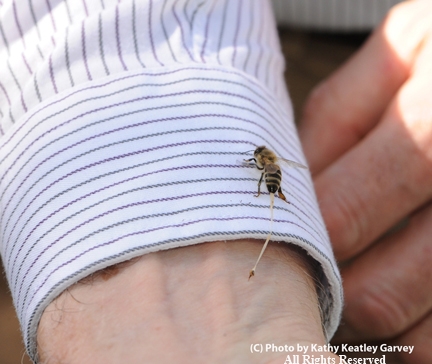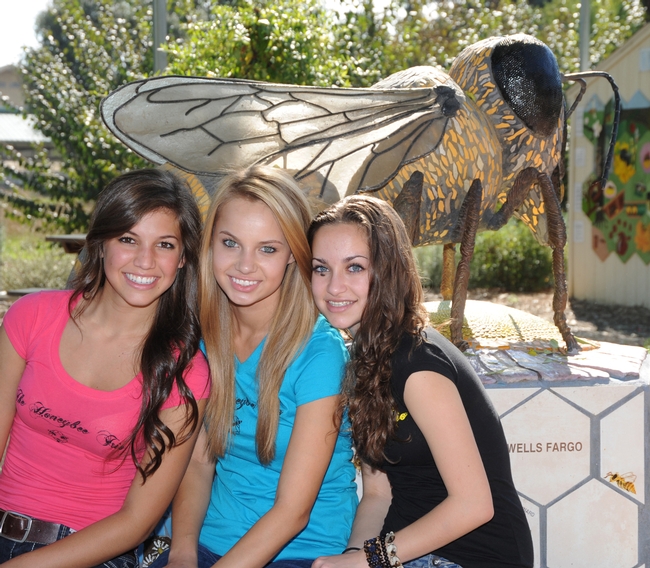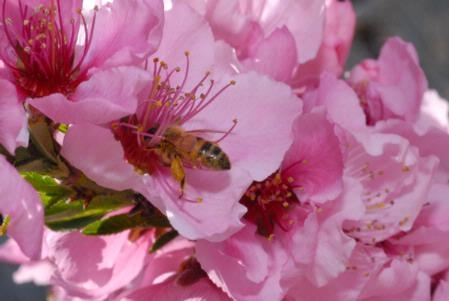
Posts Tagged: honeybee
Give Her Some Space
If you see a news story about "honey bees" in a newspaper or magazine, odds are you'll see it spelled as one word, "honeybees." That's because the Associated Press Stylebook, the journalists' "bible," spells it that way. So do dictionaries. However, in the entomological...

A honey bee queen on a finger. (Photo by Kathy Keatley Garvey)
The Sting
I've been asked how I did it. How did I manage to capture that rare image of a honey bee sting that won the feature photo award presented June 11 by the international Association for Communication Excellence (ACE)? The bee is tugging a long strand of abdominal tissue as it tries to...

FIRST PHOTO--When honey bees sting, it's usually a clean break. Extension apiculturist Eric Mussen getting stung. (Copyrighted, All Rights Reserved, Photo by Kathy Keatley Garvey)

SECOND PHOTO--Honey bee pulling out abdominal tissue. This photo won the ACE feature photo award. (Copyrighted, All Rights Reserved, Photo by Kathy Keatley Garvey)

THIRD PHOTO--Honey bee trying to escape after stinging. Worker bees die after stinging, which usually occurs while they're trying to defend their hive. (Copyrighted, All Rights Reserved, Photo by Kathy Keatley Garvey)

FOURTH PHOTO--A strand of abdominal tissue. (Copyrighted, All Rights Reserved, Photo by Kathy Keatley Garvey)
Show Me the Honey! (And the Wonder of Bees!)
Honey in the morningHoney in the eveningHoney at suppertimeBe my little honeyAnd love me all the time... So sang the McGuire Sisters in their 1958 hit tune, "Sugartime." And so will sing the Honeybee Trio of Vacaville at the Honey! event on Friday, Oct. 21 in the UC Davis Conference Center. The...

Honeybee Trio is comprised of (from left) Karli Bosler, 16; Natalie Angst, 16, and Sarah McElwain, 15. In back is Donna Billick's bee sculpture. (Photo by Kathy Keatley Garvey)
A couple of brief takes on bees
The KQED blog "News Fix" included a quick update yesterday about the California deep freeze that fizzled.
"It didn't snow in San Francisco — not really — or anywhere else near sea level late last week. Boo hoo. Let's get over it," wrote Dan Brekke.
But it was cold, so Brekke spoke to UC Cooperative Extension farm advisor Joe Connell about the effect of the cool February temperatures on California's almond crop.
Honeybees don’t like to fly in rain or freezing temperatures, Connell told him, so almond pollination has been delayed.
In other bee news, Southwest Airlines in-flight magazine Spirit highlighted a surprising fact: A bee produces just one-twelfth of a teaspoon of honey in its lifetime.
Each worker bee will fly 37,400 miles from flower to flower gathering nectar for that tiny bit of sweetener.
The queenbee's role was detailed by UC Davis honeybee expert Eric Mussen: “While the queen lays more than 1,000 eggs a day, other bees are busy feeding her, guarding the hive, and fanning the nectar with their wings to extract moisture, turning it into honey.”

A honeybee in a nectarine blossom.
Honey bee haven home to 6 million bees
The new Häagen-Dazs Honey Bee Haven at UC Davis will be dedicated Sept. 11, but it is already buzzing with activity, according to a feature that appeared in Saturday's Sacramento Bee.The half-acre refuge is already home to more than 6 million bees representing 55 species, including bumblebees, carpenter bees, leaf cutters, borer bees, mason bees and sweat bees, the article said.
The garden was transformed from a neglected patch of land - described as a giant concrete brick by the program manager - into a bee sanctuary of mostly drought-tolerant, easy-care perennials and shrubs that bloom year round. The compost for the garden came from scraps from campus cafeterias. A giant honey bee sculpture sits on a pedestal decorated with mosaics by schoolchildren, UC Davis students and others.
Interest in bees has grown in recent years due to the insects' well-publicized struggle with colony collapse disorder.
"A lot of people are asking, 'What can I do to help?'" UC Davis entomologist Eric Mussen told Bee reporter Debbie Arrington.
Many California crops are dependent on bees for pollination, such as melons, squash, cucumbers, cranberries, raspberries, strawberries, blueberries, sunflowers, alfalfa, buckwheat, clover and almonds.
"We grow more than 700,000 acres of almonds in California, and every acre needs two to three hives," the story quoted Kathy Garvey of the UC Davis entomology department.
The Häagen-Dazs Honey Bee Haven is open to the public everyday from dawn to dusk. The grand opening is from 10 a.m. to 2 p.m. Sept. 11. For more information and directions to the haven, see the Häagen-Dazs Honey Bee Haven website.

The bee sculpture in the Häagen-Dazs Honey Bee Haven at UC Davis.
